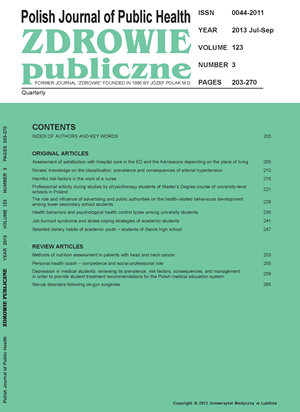Methods of nutrition assessment in patients with head and neck cancer
DOI:
https://doi.org/10.12923/j.0044-2011/123-3/a.09Słowa kluczowe:
head and neck cancer, malnutrition, assessment of nutrition statusAbstrakt
The head and neck tumors constitute large and complex group. The incidence of malnutrition in patients with head and neck tumors averages from 65 to 75%. That gives them the third place behind the pancreas and stomach tumors. The correct assessment of nutrition helps to recognize the degree of malnutrition and has influence on nutrition care and therapy. The dietary interview, anthropometric methods, bioimpedance and labolatory tests are used in evaluation of nutritional state in various scale. The degree of malnutrition has an influence on number of complications and extends the period of hospitalization, thus the methods evaluating the nutrition are commonly used in clinical practice.
The objective of this article is to introduce the readers to the methods of nutrition assessment in patients with head and neck cancer.
Bibliografia
1. von Meyenfeldt M. Cancer associated malnutrition: an introduction, Eur J Oncol Nurs. 2005;9(2);S35-S39.
2. Stratton RJ, Green CJ, Elia M. Prevalence of disease-related malnutrition. In: RJ. Stratton, CJ. Green, M. Elia (ed). Disease Related Malnutrition: An Evidence-Based Approach to Treatment. Wallingford, Oxon: CABI Publishing; 2003. p.35-92. Review match
3. Bosaeus I, Daneryd P, Svanberg E, Lundholm K. Dietary intake and resting energy expenditure in relation to weight loss in unselected cancer patient. IJC. 2001;93(3):380-3. Review match
4. Swora E, Derc K, Grzymisławski M, Golusiński W. Nutrition In patients with head and Neck tomours. Gastroenterol Pol. 2009;16(1):69-76.
5. van Bokhorst-de van der Schuer MEA, van Leeuven PAM, Kuik DJ, et al. The impact of nutritional status on the prognoses on patients with advanced head and neck cancer. Cancer. 1999;81;80-6.
6. Righini CA, Timi N, Junet P, et al. Évaluation du statut nutritionnel, lors du diagnostic, des patients traités pour un cancer des voies aérodigestives supérieures (VADS). Annales françaises d’Oto-rhino-laryngologie et de Pathologie Cervico-faciale. 2013;130(2):8-14. Review match
7. Bosy-Westphal A, Danielzik S, Dörhöfer RP, et al. Phase angle from bioelectrical impedance analysis: population reference values by age, sex, and body mass index. JPEN. 2006;30(4):309-16. Review match
8. Simons JPFHA, Schols AMWJ, Westerterp KR, et al. The use of bioelectrical impedance analysis to predict total body water in patients with cancer cachexia. Am J Clin Nutr. 1995;61(4):741-5. Review match
9. Baker JP, Detsky AS, Wesson DE, et al. Nutritional assessment: a comparison of clinical judgment and objective measurements. N Engl J Med. 1982;306;969-72.
10. Jagielska B. Leczenie żywieniowe jako terapia wspomagająca w onkologii. In: J. Meder. Podstawy onkologii klinicznej. Warszawa; 2011.
11. Ritchie SF, Navolotskaia O. Serum Proteins in Clinical Medicine. Scarborough, Foundation for Blood Research; 1996.
12. Szawłowski A. Zaburzenia odżywiania i zasady sztucznego żywienia u chorych na nowotwory. In: M. Krzakowski (ed). Onkologia Kliniczna. Warszawa: Wydawnictwo medyczne Borgis; 2001. p. 435-53.


